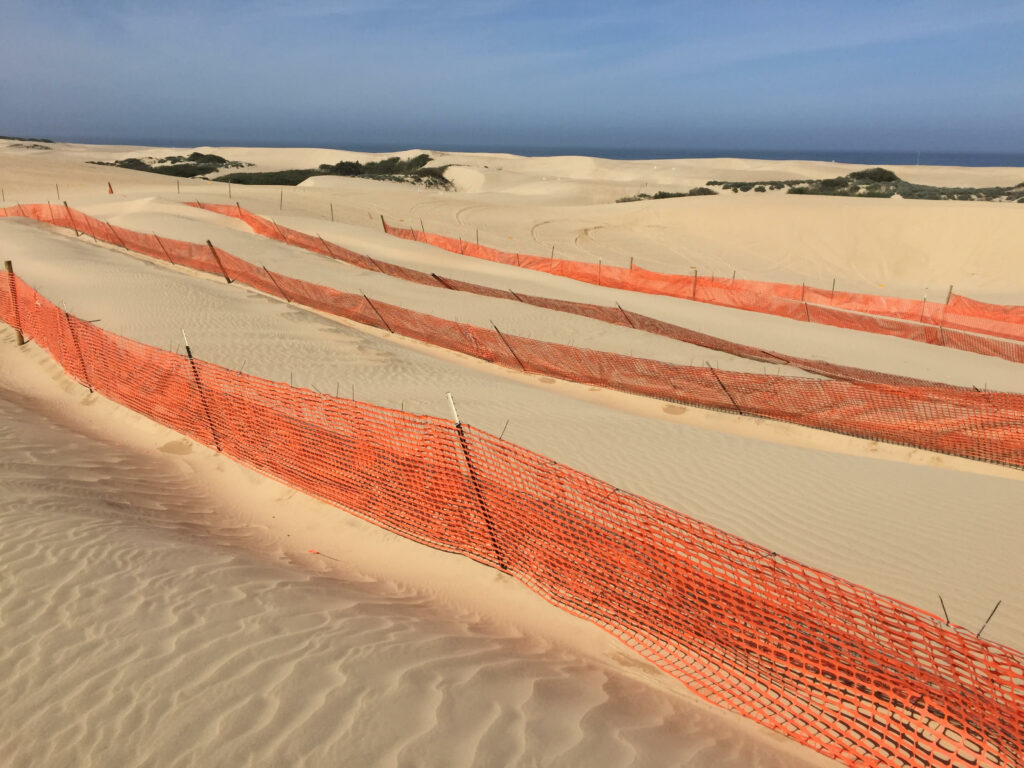State Commission points to fatal flaw in APCD Oceano Dunes dust science
May 20, 2022

Oceano Dunes dust mitigation fencing
By KAREN VELIE
State commissioners accuse San Luis Obispo County Air Pollution Control District (APCD) staff of failing to follow the basic standard of practice for computer modeling in determining the origin of dust blowing on the Nipomo Mesa, according to a May 13 letter from the State Parks Off-Highway motor Vehicle Recreation Commission to the APCD.
State Parks entered into a stipulated order of abatement with the APCD in 2018. The order requires the state to reduce wind-blown dust, specifically dust particles that are 10 microns or less in diameter, on the Nipomo Mesa by 50%.
The order of abatement requires the use of computer modeling to determine if covering the dunes with vegetation and fencing is meeting its dust reduction demand. Based on findings from the prestigious Scripps Institution of Oceanography, the validity of the APCD’s computer modeling is now in question.
Computer models that simulate the real world are based on assumptions. For a computer model to follow the standard of practice, those assumptions must be validated with real world data. If the real world data does not correspond with those assumptions, then the model and the premise for the model are invalid, according to the letter.
For more than a decade, the APCD has claimed that on windy days, particulate pollution detected on the mesa consists of 100% mineral dust particles from the Oceano Dunes State Vehicular Recreation Area, which is located more than two miles from the mesa.
In their letter, the commissioners refer to the process of dust emissions as saltation, which is a “natural dune building process that causes sand and finer material to be pushed and bounced downwind.” The saltation process generates mineral dust.
The APCD claims that the particulate pollution is comprised entirely of mineral dust. In its attempt to appease the APCD, State Parks has spent more than $22 million to stop saltation in the dunes by planting vegetation and installing fencing.
The APCD and its Scientific Advisory Group use computer models to determine the effectiveness of the vegetation and fencing on lowering pollution on the mesa based on the false assumption that 100% of the particulate blowing on the mesa is mineral dust from the Oceano Dunes.
The prestigious Scripps Institution of Oceanography analyzed the particulate and determined only 14% of the particles blowing on the mesa consist of mineral dust. In their letter, the commissioners cite the Scripps study as evidence that “appears to invalidate the APCD’s Scientific Advisory Group’s modeling, and with it, the basic premise of the abatement order.”
The commissioners ask that “all constituents of PM 10 dust be considered,” including construction and agriculture.
“If there are other sources for the alleged downwind problem, those sources should be identified and quantified by the APCD and the Scientific Advisory Group so that State Vehicle Recreation Area is not the sole bearer of responsibility,” according to the letter.
Additionally, the commissioners determined the dust mitigation measures have been a “disaster” for off-highway vehicle enthusiasts “who for decades have enjoyed riding and camping at the Oceano Dunes.”
In their letter, the commissioners are asking that in the future, any “dust mitigation features in the dunes, if they are needed at all, should be located outside of the State Park riding areas, and the cost of such mitigation should not be borne by the Off-Highway Vehicle Trust Fund.”
“If these and other issues cannot be resolved, this commission recommends that California State Parks consider withdrawing from the stipulated order of abatement,” according to the letter.






The comments below represent the opinion of the writer and do not represent the views or policies of CalCoastNews.com. Please address the Policies, events and arguments, not the person. Constructive debate is good; mockery, taunting, and name calling is not. Comment Guidelines